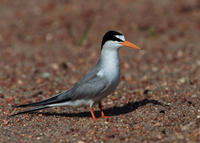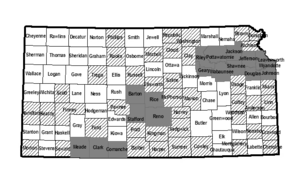LEAST TERN

This smallest of the North American terns is 8-10 inches long with a wingspread of about 20 inches. The adult is white below and grayish above with a black cap and white forehead. The leading edge of the wing primaries is also black.
Least Terns are summer residents in Kansas. Nesting birds have been recorded in six central and western Kansas counties, Jeffery Energy Center and along the Kansas River. Terns require barren areas near water such as saline flats in salt marshes, sand bars in river beds, and shores of large impoundments. A dependable food supply of small fish and aquatic crustaceans must be nearby.
Least Terns may occur accidentally or occasionally as transients anywhere in the state. The marked counties are the only ones for which reliable records are known.

Least Terns are protected by the Kansas Nongame and Endangered Species Conservation Act, the Federal Endangered Species Act, and state and federal regulations applicable to those acts. Any time a project is proposed that will likely impact the critical habitats designated below, the project sponsor must contact the Ecological Services Section, Kansas Department of Wildlife, Parks and Tourism, 512 SE 25th Ave., Pratt, Kansas 67124-8174. Department personnel can then advise the project sponsor on permit requirements under Kansas statutes. Sponsors of project impacting Least Tern habitats must also contact the Endangered Species Specialist, U.S. Fish and Wildlife Service, 315 Houston Street, Suite E, Manhattan, Kansas 66502.
DESIGNATED CRITICAL HABITATSAs defined by Kansas Administrative Regulations, critical habitats include those areas documented as currently supporting self-sustaining population(s) of any threatened or endangered species of wildlife as well as those areas determined by the Kansas Department of Wildlife, Parks and Tourism to be essential for the conservation of any threatened or endangered species of wildlife.
Currently, the following areas are designated critical for Least Terns:
(1 ) All lands and waters within the current active main stem channel of those reaches of the Cimarron River located in Clark, Comanche, and Meade counties.
(2) All lands and waters within the boundaries of Cheyenne Bottoms Wildlife Area in Barton County.
(3) All lands and waters within Quivira National Wildlife Refuge in Stafford, Reno, and Rice counties.
(4) In Pottawatomie County, all lands and water within 5 miles of the Jeffrey Energy Center, Secs. 6 & 7, T9S, R12E) and (Secs. 1, 12, T9S, R11E).
(5) All the waters within a corridor along the main stem of the Kansas River from the confluence of the Smoky Hill River and Republican River on Fort Riley in Geary County to the confluence of the Missouri River in Kansas City, Wyandotte County.
The U.S. Fish and Wildlife Service has authority to designate areas of critical habitat for federally listed endangered species, but has not done so for Least Terns in Kansas.







